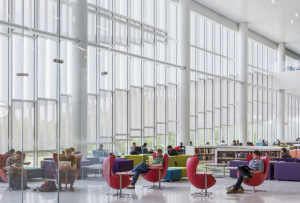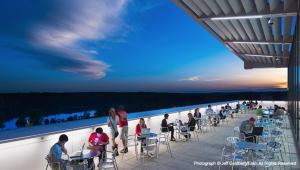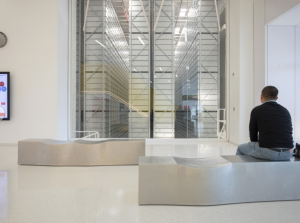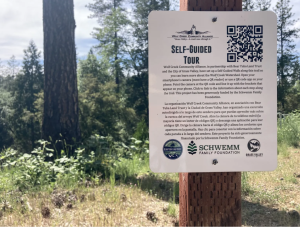The Hyperlinked Environments Module really made me think about how space and design in libraries and museums/art installations are used to create a feeling within a person. The Hunt Library Story (2013) shows us an example of an indoor space designed to encourage wonder, comfort, and discovery. SnØhetta, the architects that designed The Hunt Library, worked with North Carolina State University to create spaces that were meant to help users feel an experience (NC State, 2013). The Hunt Library interacts with nature from the inside out using glass façades as a structural feature instead of concrete, allowing views of the natural landscape to be part of the experience, perhaps creating feelings of tranquility and peace. The modern interior design is created to spark interest and comfort by creating multiple sections designed with interesting and ever-changing colors, textiles, and furniture that invoke curiosity and surprise as the user explores the multi-level building.

(NC State Hunt Library Rain Garden Reading Room, Image from NC State Website)

(NC State Hunt Library, Skyline Terrace. Image from NC State Website.)
The Hunt Library also has interactive study rooms with plenty of access to resources to help students collaborate and learn from each other creating new ideas and self-discovery. Behind the scenes, the library has a bookBot. The Robot Alley uses just one-ninth the space of conventional shelving, transforming “this 21st-century library from a storage facility into a rich environment of learning and collaborative spaces.” (NC State, n.d.)

(NC State Hunt Library, Robot Alley – bookBot center. Image from NC State website.)
I was also intrigued by the Sit and Surf (2023) article describing the benefits of solar powered bench stations installed outdoors, that allowed users free access to Wi-Fi and charging outlets during Covid-19. For example, the Pioneer Library Systems installed six solar powered benches around natural settings like walking paths throughout Norman, Oklahoma for the community to use during Covid-19.

(Image from Sit and Surf, 2023)
The library set up QR codes at the stations for users to scan and get access to the library’s digital resources like eBooks and audio books. “These benches were a clear way for us to provide access to resources and tools that enrich lives and to deliver equitable access to online services that are essential to personal well-being and success,” (Furbee, 2023). In a time of isolation, having free Wi-Fi access in a peaceful, outdoor space could have created feelings of hope.
These two very different libraries designed spaces with the user’s experience in mind: to create a library space that encouraged positive feelings. This concept made me think about libraries with limited budgets who are looking for opportunities to connect and inspire their community. In both stories, nature and technology were main features in the designs. (the bookBot, even though it was out of sight, out of mind, was the main reason the library had so much open space.) A library with limited funds could design a self-guided nature walk or a historical town tour using spaces that already exist and are ready to be learned about and explored. Investing in a low cost QR generating software the library can place user friendly QR codes with instructions around the town where people can use their digital devices and connect to the libraries website directing them to the tour(s) and other library resources. (Das, I. & Das, D., 2021). These self-guided tours can create feelings of intrigue and unity, building a stronger bond with community and the environment. The image below is a great example of a self-guided nature tour that could be an inspiration for a library to use and design from, using outdoor space to connect the community to the environment with a QR code.

(Image from YubaNet.com, 2023)
References:
Das, I. & Das, D. (2021). QR code and its effectiveness in library services. Library Philosophy and Practice (e-journal). 5540. https://digitalcommons.unl.edu/libphilprac/?utm_source=digitalcommons.unl.edu%2Flibphilprac%2F5540&utm_medium=PDF&utm_campaign=PDFCoverPages
Furbee, B. (2023, May 1). Sit and surf: high-tech benches bridge digital divide. American Libraries.com. https://americanlibrariesmagazine.org/2023/05/01/sit-and-surf/
NC State University Libraries. (n.d.) bookBot and collections. https://www.lib.ncsu.edu/hunt/bookbot#:~:text=Requiring%20one%2Dninth%20the%20space,holds%20about%20125%E2%80%93150%20books.
North Carolina State University. (2013, July 30). The hunt library story (updated). [Video]. YouTube. https://www.youtube.com/watch?v=Okr78MUrImI
Wolf Creek Alliance (2023, June 2). Wolf Creek community alliance completes installation of two self-guided walks and two interpretive bicycle tours in Grass Valley. YubaNet.com. https://yubanet.com/regional/wolf-creek-community-alliance-completes-installation-of-two-self-guided-walks-and-two-interpretive-bicycle-tours-in-grass-valley/

Hi Christine,
Thank you for your insights on using nature and technology to create positive feelings for the user. Hunt library is such a beautiful space, and I love that nature is an integral part of the library design. I love the idea of solar powered benches to provide access to wi-fi and library resources. Thank you for highlighting these libraries.
@christines you included some amazing photos in this post about various information environments, and what is possible with technology. I’ve always found the hunt library model to be so impressive. The self guided Trail application via a QR code is super cool. QR codes have come a long way.